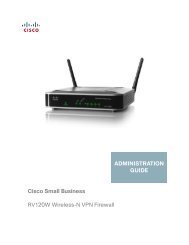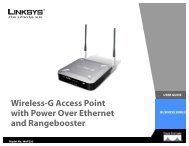Cisco Catalyst 6500 Supervisor 2T Architecture - Ipland
Cisco Catalyst 6500 Supervisor 2T Architecture - Ipland
Cisco Catalyst 6500 Supervisor 2T Architecture - Ipland
Create successful ePaper yourself
Turn your PDF publications into a flip-book with our unique Google optimized e-Paper software.
White PaperPFC4 <strong>Architecture</strong>The PFC4 is made up of two main ASIC processing blocks, along with a number of high-speed memory blocks thatserve to provide the hardware acceleration of selected features. One ASIC block performs Layer 3 services, whilethe other ASIC block performs Layer 2 services. A high-level view of the PFC4 is shown in the following diagram.Figure 10.PFC4 Functional BlocksAt the center of the PFC4 complex are the two forwarding engines. These two ASIC complexes are responsible forthe forwarding of all Layer 2 and Layer 3 packets in hardware. Attached to each of these ASIC blocks are a series oftables that are used to store information that facilitates the forwarding of packets in hardware.The following sections provide more details about each of these two forwarding engines and the associated tableswith which they interface.Layer 2 Forwarding EngineThis engine is responsible for Layer 2 packet processing and supports a number of enhancements beyond thosefound on the Layer 2 forwarding engines in previous PFC3x complexes. Integrated into the forwarding engine ASICis a MAC address table containing 128 K entries. The MAC address table consists of two banks of 4 K lines with 16entries per line (2 x 4 K x 16 = 128 K entries). Each entry in the MAC address table is 115 bits wide, and containsforwarding and aging information related to a destination MAC entry and an associated bridge domain pair.Rather than running a hash operation to find a pointer into the first bank, and then run the hash again to derive apointer into the second bank, two simultaneous hash functions are performed at the same time to provide a pointerinto each of the memory banks. In this manner, the Layer 2 lookup performance is maximized.Prior to PFC4, every interface in the system was identified by a VLAN ID, including internal uses such as L3 subinterfaces,VPNs, tunnels, and egress multicast replication-mode. This restricted the total number of unique© 2011-2012 <strong>Cisco</strong> and/or its affiliates. All rights reserved. This document is <strong>Cisco</strong> Partner Confidential Information. Page 29 of 46
















